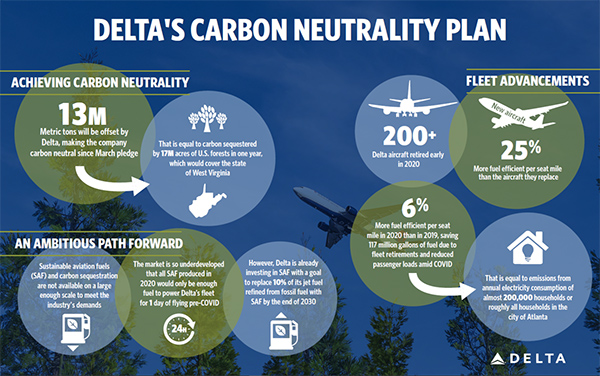
How Delta is mapping a path to zero impact aviation
At Delta, we believe customers shouldn’t have to choose between seeing the world and saving it.
Delta’s ambitious carbon neutrality plan balances immediate actions and long-term investments on path to zero-impact aviation
Delta Air Lines’ audacious commitment to carbon neutrality from March 2020 onward is coming to fruition with swift impact through immediate actions coupled with long-term investments to combat climate change.
In the short term, Delta intends to achieve carbon neutrality by directly reducing emissions through fleet and operational efficiencies and addressing remaining emissions through carbon offset project investments that maintain, protect and expand forests.
An ambitious path forward
Delta’s vision is zero-impact aviation: air travel that does not damage the environment directly or indirectly via greenhouse gas emissions, noise, waste generation or other environmental impacts.
As Delta works to solve its largest impact on the environment—carbon dioxide emissions—it plans to invest in innovative solutions, like carbon capture and storage and sustainable aviation fuels (SAF). SAF and other advanced technologies are not available on a large enough scale to meet today’s industry demands. The market is so underdeveloped that all SAF produced in 2020 would only power Delta’s fleet for one day pre-COVID. This is why investments, guided by a strong long-term vision, are so critical.
Delta’s holistic environmental sustainability plan remains focused on three areas:
- Carbon reduction and removal
- Stakeholder engagement
- Coalition building
Achieving this ambitious goal will require significant capital investment, support from government partners, research and development from manufacturers and evolution of some of the world’s largest industries.
Learn more about Delta's path to sustainability in the Part 2 of this news series or visit Delta NewsHub.










